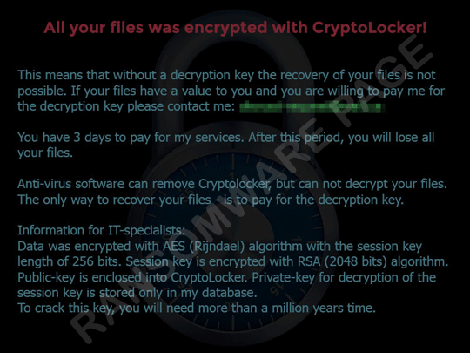TROJ_CRYPTOLOCKER.A
Troj/Ransom-AIE (Sophos), W32/Inject.NLXO!tr (Fortinet), Trojan.Ransomer, Trojan.Ransomer (Ikarus), Trojan-Ransom.Win32.Rack.a (Kaspersky), Ransom:Win32/Crilock.D (Microsoft), Win32/Filecoder.NBS trojan (Nod32), Trojan.Win32.Generic.pak!cobra (Sunbelt), TR/Crilock.360448 (Antivir)
Windows 2000, Windows Server 2003, Windows XP (32-bit, 64-bit), Windows Vista (32-bit, 64-bit), Windows 7 (32-bit, 64-bit)


Threat Type: Trojan
Destructiveness: No
Encrypted: Yes
In the wild: Yes
OVERVIEW
Downloaded from the Internet, Dropped by other malware
This Trojan arrives on a system as a file dropped by other malware or as a file downloaded unknowingly by users when visiting malicious sites.
TECHNICAL DETAILS
360,448 bytes
EXE
Yes
30 May 2014
Encrypts files
Arrival Details
This Trojan arrives on a system as a file dropped by other malware or as a file downloaded unknowingly by users when visiting malicious sites.
Installation
This Trojan drops the following copies of itself into the affected system:
- %Windows%\{random characters}.exe
(Note: %Windows% is the Windows folder, which is usually C:\Windows.)
Autostart Technique
This Trojan adds the following registry entries to enable its automatic execution at every system startup:
HKEY_LOCAL_MACHINE\SOFTWARE\Microsoft\
Windows\CurrentVersion\Run
{random characters} = "%Windows%\{random characters}.exe"
Other System Modifications
This Trojan adds the following registry keys:
HKEY_CURRENT_USER\Control Panel\Desktop
ConvertedWallpaper Last WriteTime =
It adds the following registry entries:
HKEY_CURRENT_USER\Control Panel\Desktop
ConvertedWallpaper = "%All Users Profile%\Application Data\{random characters}.jpg"
Dropping Routine
This Trojan drops the following files:
- {path of encrypted files}\PLEASE_READ.txt
- {path and file name of encrypted files}.encrypted
- %All Users Profile%\Application Data\{random characters}.jpg
(Note: %All Users Profile% is the All Users or Common profile folder, which is C:\Documents and Settings\All Users in Windows 2000, XP, and Server 2003, and C:\ProgramData in Windows Vista and 7.)
NOTES:
This Trojan encrypts files with size greater than or equal to 1024 bytes except for the files with the following extension:
- avi
- wav
- mp3
- gif
- ico
- png
- bmp
- inf
- txt
- manifest
- chm
- log
- ini
- tmp
- lnk
- cmd
- bat
- scr
- msi
- sys
- dll
- exe
After successfully encrypting files on the infected system, it replaces the wallpaper with the image it drops in %All Users Profile%\Application Data\{random characters}.jpg:

It informs the user that the system is hacked, and can recover the encrypted files if they are willing to pay:

It deletes the original files after encryption.
SOLUTION
9.700
Step 1
Before doing any scans, Windows XP, Windows Vista, and Windows 7 users must disable System Restore to allow full scanning of their computers.
Step 2
Restart in Safe Mode
Step 3
Delete this registry value
Important: Editing the Windows Registry incorrectly can lead to irreversible system malfunction. Please do this step only if you know how or you can ask assistance from your system administrator. Else, check this Microsoft article first before modifying your computer's registry.
RESTOREStep 4
Delete this registry key
Important: Editing the Windows Registry incorrectly can lead to irreversible system malfunction. Please do this step only if you know how or you can ask assistance from your system administrator. Else, check this Microsoft article first before modifying your computer's registry.
RESTOREStep 5
Restart in normal mode and scan your computer with your Trend Micro product for files detected as TROJ_CRYPTOLOCKER.A. If the detected files have already been cleaned, deleted, or quarantined by your Trend Micro product, no further step is required. You may opt to simply delete the quarantined files. Please check this Knowledge Base page for more information.
Did this description help? Tell us how we did.

